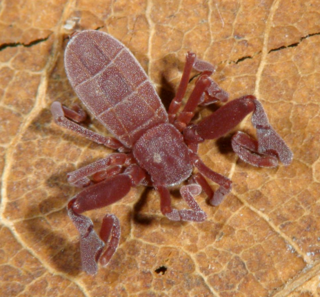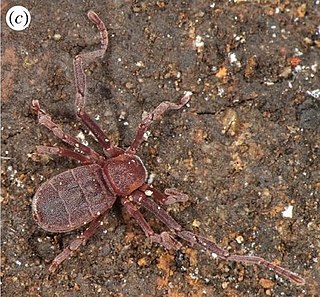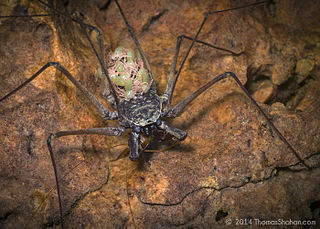
Arachnida is a class of joint-legged invertebrate animals (arthropods), in the subphylum Chelicerata. Arachnida includes, among others, spiders, scorpions, ticks, mites, pseudoscorpions, harvestmen, camel spiders, whip spiders and vinegaroons.

Ricinulei is a small order of arachnids. Like most arachnids, they are predatory, eating small arthropods. They occur today in west-central Africa (Ricinoides) and the Neotropics as far north as Texas. As of 2021, 91 extant species of ricinuleids have been described worldwide, all in the single family Ricinoididae. In older works they are sometimes referred to as Podogona. Due to their obscurity they do not have a proper common name, though in academic literature they are occasionally referred to as hooded tickspiders.

The pygidium is the posterior body part or shield of crustaceans and some other arthropods, such as insects and the extinct trilobites. In groups other than insects, it contains the anus and, in females, the ovipositor. It is composed of fused body segments, sometimes with a tail, and separated from thoracic segments by an articulation.
P. mitchelli may refer to:

Ricinoides is an arthropod genus in the family Ricinoididae, first described by Henry Ewing in 1929.
Robert Wetsel Mitchell was an American invertebrate zoologist and photographer who was particularly active in the study of the biology of caves.

Cryptocellus is an arachnid genus in the order Ricinulei, first described by John Westwood in 1874. It is native to the Neotropics.
Cryptocellus adisi is an arachnid species in the order Ricinulei. It occurs in Central Amazonia in Brazil.

Pseudocellus is an arachnid genus in the order Ricinulei, first described by Norman Platnick in 1980. It is native to the Neotropics.

Pseudocellus pearsei is an arachnid species in the order Ricinulei. It occurs in caves in Yucatan, Mexico.
Pseudocellus mitchelli is an arachnid species in the order Ricinulei. It is endemic to caves in Durango, Mexico. The specific epithet is a tribute to cave biology specialist Robert W. Mitchell.
Pseudocellus bolivari is an arachnid species in the order Ricinulei. It occurs in caves in Chiapas, Mexico. The specific epithet is a tribute to Cándido Luis Bolívar y Pieltáin.
Pseudocellus boneti is an arachnid species in the order Ricinulei. It occurs in the Cacahuamilpa cave system in Guerrero, Mexico.
Pseudocellus cookei is an arachnid species in the order Ricinulei. It occurs only in the cueva Jobitzinaj in Petén, Guatemala.

Phrynidae is a family of amblypygid arachnida arthropods also known as whip spiders and tailless whip scorpions. Phrynidae species are found in tropical and subtropical regions in North and South America. Some species are subterranean; all are nocturnal. At least some species of Phrynidae hold territories that they defend from other individuals.
Pseudocellus barberi is a species of arachnid in the order Ricinulei. They can be found in Guatemala and Honduras. The type specimen was found in Guatemala.
Paolo Marcello Brignoli was a prominent Italian entomologist. He studied a broad range of arachnid groups, including Araneidae, Acari, Ricinulei, Palpigradi, Schizomida, Opiliones, and Amblypygi. His research mainly focused on evolutionary systematics, taxonomy, and biogeography. Over the course of his career, he described 23 new genera and 367 new species belonging to 33 different arachnid families. The International Society of Arachnology's Brignoli Award is named in his honor.






